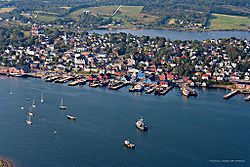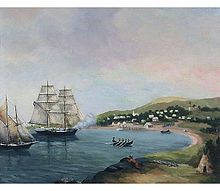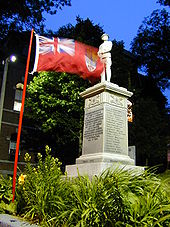- Lunenburg, Nova Scotia
-
Not to be confused with Lunenburg County, Nova Scotia or Lunenburg (municipal district), Nova Scotia.
Old Town Lunenburg * UNESCO World Heritage Site
Country Canada Type Cultural Criteria iv, v Reference 741 Region ** Europe and North America Inscription history Inscription 1995 (19th Session) * Name as inscribed on World Heritage List
** Region as classified by UNESCOLunenburg (2006 population: 2,317), is a Canadian port town in Lunenburg County, Nova Scotia.
Situated on the province's South Shore, Lunenburg is located on a peninsula at the western side of Mahone Bay. The town is approximately 90 kilometres southwest of the county boundary with the Halifax Regional Municipality.
The town was established during Father Le Loutre's War. The historic town was designated a United Nations Educational, Scientific and Cultural Organization (UNESCO) World Heritage Site in 1995. This designation ensures protection for much of Lunenburg's unique architecture and civic design, being the best example of planned British colonial settlement in North America.
Contents
History
Foreign Protestants
For over a hundred years, Lunenburg was an Acadian/ Mi’kmaq village named Mirligueche. It was established under the command of Isaac de Razilly in the first half of the seventeenth century.[1] In 1745 there were reported to be only eight settlers in the village. Four year later, Cornwallis reported that there were a number of families that lived in comfortable wooden houses.[2]
Despite the British Conquest of Acadia in 1710, Nova Scotia remained primarily occupied by Catholic Acadians and Mi'kmaq. Father Le Loutre's War began when Edward Cornwallis arrived to establish Halifax with 13 transports on June 21, 1749.[3] By unilaterally establishing Halifax the British were violating earlier treaties with the Mi'kmaq (1726), which were signed after Dummer's War.[4] Upon the outbreak of Father Le Loutre's War, on October 5, 1749, Governor Edward Cornwallis sent Commander White with troops in the 20 gun sloop Sphinx to Mirligueche (i.e., Lunenburg) and had the village destroyed.[5] By 1753 there still was only one family in the area - a Mi'kmaq man named "Old [Paul] Labrador" and his metis family.[6]
After establishing Halifax, the British quickly began to build other settlements. To guard against Mi'kmaq, Acadian and French attacks on the new protestant settlements, British fortifications were erected in Halifax (1749), Dartmouth (1750), Bedford (Fort Sackville) (1751), Lunenburg (1753) and Lawrencetown (1754). The Natives and Acadians raided the Lunenburg peninsula nine times in the first six years of its establishment.[7]
Three years into the war, John Creighton led a group of Foreign Protestants to settle the area and renamed it Lunenburg (1753).[8] In 1753, during Father Le Loutre's War, the British unilaterally established Lunenburg, that is, without negotiating with the Mi'kmaq people. In the spring, Governor Hopson was received warnings from Fort Edward that as many as 300 natives nearby were prepared to oppose the settlement of Lunenburg and intended to attack upon the arrival of settlers. Supervised by Lawrence and protected by several ships of the British Navy and by 160 Regular soldiers, protestant settlers established the village. [9]
The original inhabitants of Lunenburg (mostly Germans from the southern Rhineland, Swiss and French Protestants from Montbéliard) came during the same wave of immigration that produced the Pennsylvania Dutch. They were "Foreign Protestants" encouraged by the British to settle in the area.[10] Lunenburg was settled by Foreign Protestants who came from the present day Tripoint of France, Germany and Switzerland. The town was named in honour of King George II, who also happened to be the duke of Braunschweig-Lüneburg.[11]
The Hoffman Insurrection
During Father Le Loutre's War, in mid December 1753, within six months of their arrival at Lunenburg, the new settlers rebelled against their living conditions. The rebellion became known as "The Hoffman Insurrection." The Rebellion was led by John Hoffman, one of the Captains who had established the settlers in the town.
Hoffman led a mob which eventually locked up in one of the blockhouses a number of Commander Patrick Sutherland’s troops and the Justice of the Peace. Commander Patrick Sutherland at Lunenburg asked for reinforcements from Halifax and Colonel Robert Monckton was sent with troops. Monckton arrested Hoffman and brought him to Halifax where he was fined and imprisoned on Georges Island (Nova Scotia) for two years.[12]
Because of the living conditions and encouragement from Le Loutre, a number of the French and German-speaking Foreign Protestants left the village to join the Acadian communities.[13]
French and Indian War
During the French and Indian War (1754–1763), the town was protected by several small blockhouses that were garrisoned by British regulars as well as by provincial troops from Massachusetts. These forts were erected to protect the town from raids by French warships and from attacks by Acadians and Indians. During the Expulsion of the Acadians, specifically the Bay of Fundy Campaign (1755), the British sent the Acadian cattle at Grand Pre to Lunenburg to support the British settlement that was established with Foreign Protestants.[14]
Raid on Lunenburg (1756)
Main article: Raid on Lunenburg (1756)There were nine raids on the Lunenburg Peninsula during the war. For example, Indians (Maliseet) attacked in the Raid on Lunenburg (1756), in which twenty settlers were killed. Despite the protection of increased number of blockhouses built on the peninsula, eight more Indian/ Acadian raids happened against those on the Lunenburg Peninsula over the next three years.[15] A total of 32 people from Lunenburg were killed in the raids with more being taken prisoner.[16] The British reported that most of these raids were by the Mi'kmaq and Acadians at Cape Sable (present-day Shelburn and Yarmouth Counties).[17]
Raids on Lunenburg (1757-1759)
Following the raid of 1756, there were eight more raids on the Lunenburg Peninsula over the next three years. In 1757, there was a raid on Lunenburg in which six people from the Brissang family were killed.[18] The following year, March 1758, there was a raid on the Lunenburg Peninsula at the Northwest Range (present-day Blockhouse, Nova Scotia) when five people were killed from the Ochs and Roder families. [19] By the end of May 1758, many of those on the Lunenburg Peninsula abandoned their farms and retreated to the protection of the fortifications around the town of Lunenburg, losing the season for sowing their grain.[20] For those that did not leave their farms for the town, the number of raids intensified.
During the summer of 1758, there were four raids on the Lunenburg Peninsula. On July 13, 1758, one person on the LaHave River at Dayspring was killed and another seriously wounded by a member of the Labrador family.[21] The next raid happened at Mahone Bay, Nova Scotia on August 24, 1758, when eight Mi'kmaq attacked the family homes of Lay and Brant. While they killed three people in the raid, the Mi'kmaq were unsuccessful in taking their scalps, which was the common practice for payment from the French.[22] Two days, later, two soldiers were killed in a raid on the blockhouse at LaHave, Nova Scotia.[23] Almost two weeks later, on September 11, a child was killed in a raid on the Northwest Range.[24]
Another raid happened on March 27, 1759, in which three members of the Oxner family were killed. [25] The last raid happened on April 20, 1759. The Mi’kmaq killed four settlers at Lunenburg who were members of the Trippeau and Crighton families.[26]
American Revolution
During the American Revolution, the American Privateers engaged in the Raid of Lunenburg (1775) and the Raid on Lunenburg (1782) and on both occasions devastated the town. In the raid of 1775, the 84th Regiment of Foot (Royal Highland Emigrants) had been defending Nova Scotia, attacking the American privateer ship off of Lunenburg, Nova Scotia, as the privateers were looting the town. The privateers were then taken to Halifax.
War of 1812
During the War of 1812, Nova Scotia’s contribution to the war effort was communities either purchasing or building various privateer ships to siege American vessels.[27] Three members of the community of Lunenburg purchased a privateer schooner and named it Lunenburg on August 8, 1814.[28] The owners were Capt. Oxner, Henry Wollenkaupt, Philip Rudolf and Henry Mosher. The schooner was ninety-three tons, five guns and a crew of forty-five men.
The Lunenburg captured the American vessel Lucy on September 15, 1814, and the American ship Ranger on November 15, both prizes were brought back to Lunenburg. One of the largest American privateer schooners the Lunenburg caught was Minerva, of Wiscasset, Maine. Another was the sloop Experiment, caught off of Point Judith, Rhode Island on January 21, 1815. Over the following weeks, the Lunenburg captured three American sloops and one schooner by February 15, 1815.[29]
After a long naval battle in Mahone Bay, the Lunenburg militia was sent to take prisoners from American Privateer Young Teazer.
Bluenose
Lunenburg has long history of building woodenships. The most famous is the world famous schooner Bluenose and her daughter Bluenose II which remains an important tourist attraction in the town, her home port.
Economy
Tourism is now Lunenburg's most important industry and many thousands visit the town each year. A number of restaurants, inns, hotels and shops exist to service the tourist trade.[30] Numerous artists operate their own galleries. The town is home to the Fisheries Museum of the Atlantic, part of the Nova Scotia Museum. The schooner replica Bluenose II is operated by the museum and based out of Lunenburg. The town is also home to the privately run Halifax and Southwestern Railway Museum and the Knaut-Rhuland House Museum.
The town has a history of being an important seaport and shipbuilding centre. There are now numerous small businesses, high-tech industries including Composites Atlantic and HB Studios, and trade plants including High Liner Foods, which was at one point the largest fish plant in Canada. This plant now handles manufacturing and most fishing is done offshore.
Culture
The 2010 Japanese movie Hanamizuki was partly set and filmed in Lunenburg[31] and the science fiction television show Haven is partly filmed there though it is set in the United States.[32] The town is featured prominently in a 2010 series of Cisco Systems network product ads featuring Ellen Page.
Panorama
Gallery
Historical populations Year Pop. ±% 1981 3,014 — 1991 2,781 −7.7% 1996 2,599 −6.5% 2001 2,568 −1.2% 2006 2,317 −9.8% [33] See also
- Lunenburg Opera House
- Royal eponyms in Canada
External links
- Town of Lunenburg
- World Heritage site
- Fisheries Museum of the Atlantic
- Photographs of the Montbeliard monument, Lunenburg
- A Short History of St. John's Anglican Church
- Basil Brownless: The Story of Lunenburg's Most Historic Church: The 250-year history of St. John's Anglican Church. Lunenburg, 2002.
- Municipality of the District of Lunenburg - Things to do in the surrounding area
- Patrick Sutherland: Founding father of Lunenburg - Canadian Biography
- John Creighton: Founding Father of Lunenburg - Canadian Biography
References
Texts
- Patterson, Stephen E. 1744-1763: Colonial Wars and Aboriginal Peoples. In Phillip Buckner and John Reid (eds.) The Atlantic Region to Conderation: A History. Toronto: University of Toronto Press. 1994. pp.125-155
- Grenier, John. The Far Reaches of Empire. War in Nova Scotia, 1710-1760. Norman: U of Oklahoma P, 2008.
- Griffiths, Naomi Elizabeth Saundaus. From Migrant to Acadian: A North American border people, 1604-1755. Montreal, Kingston: McGill-Queen's UP, 2005.
- Murdoch, Beamish. A History of Nova Scotia, Or Acadia. Vol 2. LaVergne: BiblioBazaar, 2009. pp. 166–167
- Wicken, William. Mi'kmaq Treaties on Trial: History, Land, and Donald Marshall Junior. University of Toronto Press. 2002.
Endnotes
- ^ Landry, Peter. The Lion & The Lily. Trafford Publishing. Vol. 1, pp. 44.; Grifftihs, Naomi. The Context of Acadian History 1686-1784. McGill-Queens University Press, Montreal. 1992. Pages 17, 69, 72, 80.
- ^ Bell, p. 403
- ^ Grenier, John. The Far Reaches of Empire. War in Nova Scotia, 1710-1760. Norman: U of Oklahoma P, 2008; Thomas Beamish Akins. History of Halifax, Brookhouse Press. 1895. (2002 edition). p 7
- ^ Wicken, p. 181; Griffith, p. 390; Also see http://www.northeastarch.com/vieux_logis.html
- ^ Grenier, John. The Far Reaches of Empire: War in Nova Scotia, 1710-1760.University of Oklahoma Press, Norman. 2008. Pp. 152; Expeditions of Honour: Journal of John Salusbury in Halifax, Nova Scotia, 1749-53. Edited by Ronald Ropkey. University of Delaware Press. 1982.p.68
- ^ Bell, p. 403, 430. Note that Bell indicates he does not know the reason for the decrease in population, that is, he did not know about Cornwallis' orders to raid the village late in 1749. Bell speculates that the others migrated to Ile Royal at the urging of the French (p. 483).
- ^ Bell, Foreign Protestants
- ^ The town was named in honour of the King of Great Britain and Ireland, (George August of Hanover) who was also the ruler of Brunswick-Lunenburg.
- ^ Patterson, 1994, p. 136
- ^ Many of the original families (such as the Zwickers, the Tanners and the Smiths) and their descendants still inhabit and influence the development of the town today.
- ^ Grenier. 2008. p. 166
- ^ Bell, "Foreign Protestants"
- ^ Charles Morris. 1762. British Library, Manuscripts, Kings 205: Report of the State of the American Colonies. pp: 329-330.
- ^ Charles Morris. 1762. British Library, Manuscripts, Kings 205: Report of the State of the American Colonies. pp: 329-330.
- ^ Bell, Winthrop Pickard. The "Foreign Protestants" and the Settlement of Nova Scotia:The History of a piece of arrested British Colonial Policy in the Eighteenth Century. Toronto: University of Toronto Press, 1961 pp. 504-513
- ^ Bell. Foreign Protestants. p. 515
- ^ The "Foreign Protestants" and the Settlement of Nova Scotia by Dr Winthrop Pickard Bell. p. 513
- ^ Archibald McMechan, Red Snow of Grand Pre. 1931. p. 192
- ^ Bell, p. 509
- ^ Bell. Foreign Protestants. p. 510
- ^ Bell, p. 510
- ^ Bell, Foreign Protestants, p. 511
- ^ Bell, p. 511
- ^ Bell, p. 512
- ^ Archibald McMechan, Red Snow of Grand Pre. 1931. p. 192
- ^ Bell, p. 513
- ^ John Boileau. Half-hearted Enemies: Nova Scotia, New England and the War of 1812. Halifax: Formac Publishing. 2005. p.53
- ^ C.H.J.Snider, Under the Red Jack: privateers of the Maritime Provinces of Canada in the War of 1812 (London: Martin Hopkinson & Co. Ltd, 1928), 225-258 (see http://www.1812privateers.org/Ca/canada.htm#LG)
- ^ C.H.J.Snider, Under the Red Jack: privateers of the Maritime Provinces of Canada in the War of 1812 (London: Martin Hopkinson & Co. Ltd, 1928), 225-258 (see http://www.1812privateers.org/Ca/canada.htm#LG)
- ^ The Canadian Encyclopedia
- ^ "5 Months in Total After the Start of Filming in Canada...". The Japan Times Online. cafegroove Corporation.. 2010-04-27. http://www.cinemacafe.net/news/cgi/report/2010/04/8166/. Retrieved 2011-02-15. (Japanese)
- ^ Adam Jacobs. "Movie, miniseries being filmed around Town of Lunenburg". SouthshoreNow.ca. 20 April 2010. Retrieved 10 April 2011.
- ^ I:\ecstats\Agency\BRIAN\census2
Coordinates: 44°22′37″N 64°19′08″W / 44.37694°N 64.31889°W
Categories:- Communities in Lunenburg County, Nova Scotia
- Towns in Nova Scotia
- Populated coastal places in Canada
- World Heritage Sites in Canada
- Populated places established in 1753
- General Service Areas in Nova Scotia
Wikimedia Foundation. 2010.














